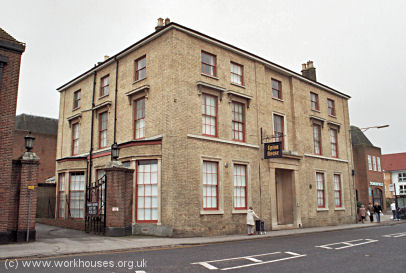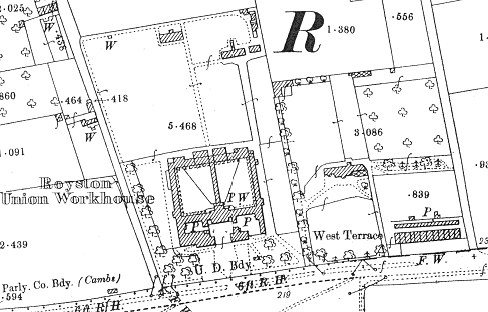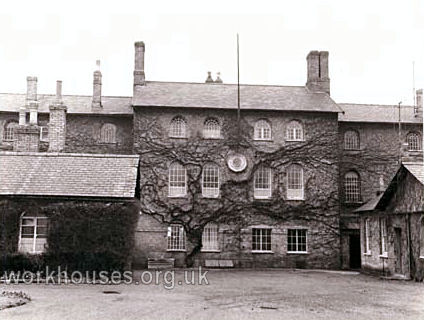Royston, Hertfordshire
Up to 1834
Parish workhouses existed in Meldreth from 1707, and in Royston from 1735 (Hampson, 1934).
A parliamentary report of 1777 recorded parish workhouses in operation at Royston (for up to 38 inmates), Ashwell (12), Barkway (30), Barley (25), Basingbourn, and Guilden Mordern (12).
Until boundary changes in the 1890s, the county border between Hertfordshire and Cambridgeshire ran through the middle of Royston. However, an Act in 1781 joined the two parts for administrative purposes. Prior to this amalgamation, Royston (Cambridgeshire) had a workhouse on Back Street (now King Street). After the uniting of the town, there was a workhouse on the London Road, where Godfreys Terrace once stood. Another was "at Whitehall, at the top of the High Street" (Kingston, 1893) - this may be the building on the south side of Baldock Street which was used as a workhouse in the early 19th century.

Royston (Herts) parish workhouse.
© Peter Higginbotham
After 1834
Royston Poor Law Union was formed on 29th June 1835. Its operation was overseen by an elected Board of Guardians, 32 in number, representing its 29 constituent parishes as listed below (figures in brackets indicate numbers of Guardians if more than one):
County of Hertford:
Ashwell, Barkway, Barley, Hinxworth, Kelshall, Nuthampstead, Reed, Royston (2), Therfield.
County of Cambridge:
Abbington Pigotts, Barrington, Bassingbourn (2), Foulmire [Fowlmere], Foxton, Kneesworth, Littlington, Melbourn (2), Meldreth, Guilden Mordern, Steeple Mordern, Royston, Shepreth, Shingay, Thriplow, Wendy, Whaddon.
County of Essex:
Heydon, Great Chishall, Little Chishall
The population falling within the Union at the 1831 census had been 15,671 — with parishes ranging in size from Shingay (population 112) to Melbourn (1,574). The average annual poor-rate expenditure for the period 1832-35 had been £10,233 or 13s.1d. per head of the population.
A new Royston Union workhouse was erected in 1835-6 at the north side at Baldock Road to the west of Royston. In 1835, the Poor Law Commissioners authorised an expenditure of £6,400 on construction of the building which was to accommodate 300 inmates. The building was designed by William T Nash, who was also the architect of Union workhouses at Bishop's Stortford, Braintree, Buntingford, Caxton & Arrington, Halstead, and St Ives. Like most of Nash's workhouse designs, Royston was based on courtyard plan, with the main buildings set around an outer rectangular perimeter. The workhouse location and layout are shown on the 1901 OS map.

Royston workhouse site, 1901.
The outer buildings were three storeys high with a number of small single-storey blocks to the front which would have contained the porter's lodge, vagrants' and receiving wards etc.

Royston workhouse entrance from the south.
After the official end of the workhouse system in 1930, control of the Royston workhouse site passed to the local council. By 1937, only the casual wards were still in use. The workhouse building, later known as Heath Lodge, was demolished in 1972.
Staff
Inmates
Records
Note: many repositories impose a closure period of up to 100 years for records identifying individuals. Before travelling a long distance, always check that the records you want to consult will be available.
- Hertfordshire Archives and Local Studies, County Hall, Pegs Lane, Hertford SG13 8DE. Holdings include: Guardians' minute books (1835-1930); Ledgers (1913-15, 1921-29); Births (1866-1929); Deaths (1866-1915); etc.
Bibliography
- Gutchen RM, Truwert E, and Peters G (1984) Down and Out in Hertfordshire — A Symposium on the Old and New Poor Law (Hertfordshire Publications)
- Hampson, E.M. (1934) The Treatment of Poverty in Cambridgeshire, 1597-1834 (Cambridge Studies in Economic History; CUP).
- Kingston, A (1893) Fragments of Two Centuries
Links
- None.
Unless otherwise indicated, this page () is copyright Peter Higginbotham. Contents may not be reproduced without permission.


